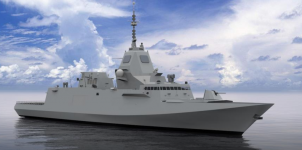Posted on 04/12/2017 by Vincent Groizeleau
As we wrote last September, Naval Group and Fincantieri have chosen to stand together for the call for bids on future Canadian frigates. Outgoing officially timber, the two companies unveiled the 1 stDecember the proposed design in Ottawa. This is a mix of multi-mission frigates built by France and Italy, responding to Canadian needs. This design is based on the Italian platform of the FREMM, the electronics being French, however, especially the combat system (Naval Group) and the radar faces Sea Fire plane (Thales). Armament side, we observe on the presented visual a turret of 127mm, two systems surface-air RAM and light artillery. To this will be added a vertical missile for surface-to-air missiles, probably Aster, which would be preferred by many Canadian servicemen given their performance, but the American missile option would still be possible. Like its French and Italian cousins, the Canadian FREMM would have first-class air defenses, but also equally robust capabilities in the fields of anti-ship and especially anti-submarine warfare, with hull sonar and towed sonar (Captas). To this will be added the action towards the earth.
This decision by Naval Group (formerly DCNS) and Fincantieri to join forces in this market enables French and Italian manufacturers, on a project where competition is fierce, to reduce competition and maximize their chances of success. "The Canadian government has announced its intention to acquire a NATO standard combat vessel, based on an existing and proven design that can be modified to meet the requirements of the Canadian Navy. Naval Group and Fincantieri, with the full support of the French and Italian governments, will combine their know-how to present to the Canadian government an off-the-shelf solution already proven at sea based on the design of the FREMM frigate, for the supply of 15 surface combatants in the Canadian Navy. In the event that this offer is accepted, future frigates would be built in Canada at the Irving Shipbuilding shipyard in a very short time frame, ensuring maximum participation of Canadian industry and local job creation through technology transfer complete and dedicated. Canadian suppliers would also be integrated into the global supply chain of both companies, "explain Naval Group and Fincantieri.
For the record, the Canadian Surface Combatant (CSC) program aims to replace, over the next decade, the 12 City frigates, commissioned between 1992 and 1996, as well as the three tribal destroyers, now all retired. They will succeed a new fleet of up to 15 buildings for an estimated budget of 26 billion Canadian dollars, or nearly 18 billion euros. The construction of the seed must be launched in the early 2020s in a site imposed by the Canadian government and with which international groups competing for design and combat system will collaborate. This is Halifax Shipyards, a subsidiary of the Irwing Group, designated in 2011 to carry out CHCs as part of the national shipbuilding strategy,
The selection process initially put in place by Canada, with a double call for tenders, one for the platform and the other for the combat system, proved to be very complex, the interested industry believing that presented too high risks and different problems, including intellectual property issues. After being alerted by several major players in the sector that they might not submit an offer in these conditions, the Canadian government has overhauled and simplified the procedure last year. Finally, 12 companies were shortlisted in the summer of 2017 to continue the competition and submit an offer.
Apart from Naval Group and Fincantieri, were selected (in alphabetical order) the American engineering company Alion Science and Technology, the German Atlas Elektronik, the British BAE Systems, Lockheed Martin Canada, the Navantia Spaniard, the Danish Odense Maritime Technology, Saab Australia, Italian Leonardo, Thales Nederland and German TKMS.
These different manufacturers came together to submit joint offers on November 30th. Among them, there is the solution, considered by many observers as a favorite starter, of an adaptation of the future British frigate type 26, with a consortium of Lockheed Martin Canada, BAE Systems, CAE, L3 Technologies, MDA and Ultra Electronics. Alion Canada, for its part, presents an offer based on the design of the Dutch frigates of the LCF type, while Navantia, allied notably with Saab, submits a variant of the F100 model, built for the Spanish and Australian navies. Odense shares an evolution of the Danish Iver Huitfeldt and TKMS probably on a declination of the new German frigates type F125




